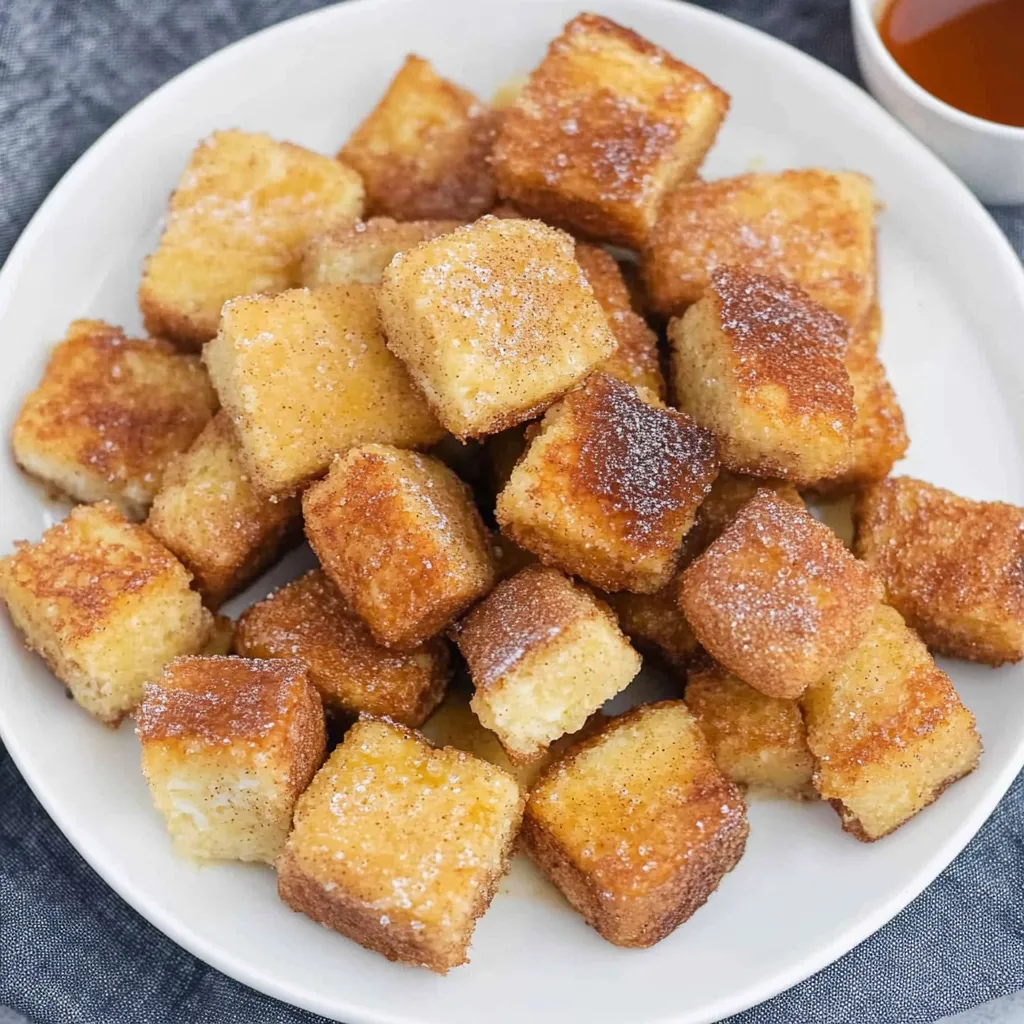 Pin it
Pin it
These irresistible cinnamon French toast bites transform ordinary bread into bite-sized morsels of breakfast perfection with minimal effort and maximum flavor. Each golden-brown cube delivers a delightful textural contrast—crisp, buttery edges giving way to a tender, custard-like center, all enveloped in a sweet cinnamon-sugar coating that creates a delicate crunch with every bite. Perfect for lazy weekend mornings when you crave something special but don't want to spend hours in the kitchen, these versatile little treats work equally well as a family breakfast, casual brunch centerpiece, after-school snack, or even dessert when paired with ice cream. The best part? They take just minutes to prepare using ingredients you likely already have in your pantry.
I discovered these delightful bites during a Sunday morning when my children were requesting "something special" for breakfast, but I wasn't prepared to undertake an elaborate cooking project. Transforming a simple loaf of bread into these cinnamon-scented cubes completely transformed our morning routine. My normally reserved husband took one bite and declared them "dangerously addictive," while my youngest, who typically leaves half her breakfast untouched, kept returning to the table for "just one more piece." Now they've become our traditional weekend treat—the perfect balance between special enough to feel like an occasion but simple enough for even the laziest mornings.
Essential Ingredients
- Thick White Bread: Forms the foundation of these heavenly bites. Thick-cut bread is absolutely essential as it maintains structural integrity when cut into cubes and doesn't become soggy when dipped in custard. Look for Texas toast, brioche, or challah for the best results—their sturdy texture and slight sweetness create the perfect base for soaking up the custard mixture without falling apart.
- Fresh Eggs: Create the rich custard bath that transforms ordinary bread into extraordinary French toast. The proteins in eggs firm up during cooking, providing structure while keeping the interior moist. Farm-fresh eggs with their vibrant yolks add extra richness and color to the finished bites.
- Whole Milk: Works with eggs to create the perfect custard consistency. The fat content in whole milk delivers richness that lower-fat alternatives simply can't match. It creates that characteristic creamy interior texture that makes French toast so irresistible while helping the exterior brown beautifully during cooking.
- Ground Cinnamon: Provides the signature warm spice note that defines this breakfast favorite. Its sweet-spicy aroma immediately signals comfort and warmth. Quality cinnamon makes a noticeable difference—look for Ceylon or Vietnamese varieties for the most aromatic experience.
- Butter: Creates the irresistible golden exterior and adds rich, savory notes that balance the sweetness. Butter's milk solids caramelize during cooking, developing complex flavors while its fat helps create that perfectly crisp exterior. Use unsalted butter to control the salt level in the final dish.
- Granulated Sugar: Forms the sweet, slightly crunchy coating that makes these bites impossible to resist. When mixed with cinnamon and tossed with warm french toast, it creates a delicate crystalline exterior that provides textural contrast with the soft interior. The sugar also caramelizes slightly during cooking, adding depth of flavor.
Step-by-Step Cooking Instructions
- Prepare your bread for optimal results -
- Begin with slightly stale bread for best texture—fresh bread tends to become too soggy. If you only have fresh bread, cut it into 1-inch thick slices and leave them uncovered for several hours or overnight, or toast them lightly in a 250°F oven for 10 minutes to remove excess moisture. Once properly dried, cut each slice into 8 even cubes, about 1-inch each. The uniform size ensures even cooking, while the slightly dry bread will absorb the custard mixture without becoming mushy. Set aside while preparing the remaining components.
- Create your cinnamon-sugar coating -
- In a shallow bowl, combine ½ cup granulated sugar and 2 teaspoons ground cinnamon, mixing thoroughly with a fork until evenly distributed. This mixture will coat the warm French toast bites immediately after cooking, creating that characteristic sweet, spiced exterior. The sugar crystals provide delightful textural contrast while the cinnamon adds warm, aromatic notes. Set this mixture aside within easy reach of your cooking area.
- Prepare your custard mixture -
- In a wide, shallow bowl, whisk together 3 large eggs, ¾ cup whole milk, ¼ teaspoon salt, and 1 teaspoon vanilla extract until completely combined with no visible egg whites. The wide bowl allows for easier dipping, while the thorough whisking ensures a uniform custard that will cook evenly. The salt enhances the flavors while vanilla adds aromatic depth. Keep this mixture nearby, ready for dipping.
- Begin the cooking process -
- Melt 2 tablespoons unsalted butter in a large non-stick skillet over medium heat until it foams but doesn't brown. The foaming indicates the butter's water content is evaporating, leaving the fat and milk solids to work their magic. Medium heat is crucial—too high will burn the exterior while leaving the interior soggy; too low won't develop that golden crust. The butter should coat the pan evenly, creating a consistent cooking surface.
- Dip and cook your first batch -
- Working quickly, toss half the bread cubes in the egg mixture, gently turning to coat all sides but not allowing them to soak for more than 30 seconds. Using a slotted spoon or your fingers, transfer the cubes to the hot pan, arranging them in a single layer with space between each piece. This spacing allows steam to escape, creating crisp rather than soggy sides. Cook for about 45-60 seconds on each side, using tongs to turn them, until all sides are golden brown and slightly crisp. The entire process should take 3-4 minutes per batch.
- Coat while warm for maximum adherence -
- Immediately transfer the hot French toast bites to the cinnamon-sugar mixture. Gently toss to coat all sides evenly, then transfer to a serving plate. This immediate coating while the bites are still hot and slightly moist allows the sugar mixture to adhere perfectly, creating that delightful sweet crust. Don't delay this step or the sugar won't stick properly.
- Complete the cooking process -
- Add the remaining 2 tablespoons butter to the pan and repeat the process with the second batch of bread cubes. Using fresh butter for the second batch ensures the same golden-brown quality without any burnt bits from the first batch. Once coated, arrange all the bites on a serving platter. For the most delightful experience, serve immediately while still warm, accompanied by maple syrup, whipped cream, or fruit compote for dipping.
 Pin it
Pin it
The Magic of Bite-Sized Breakfast
There's something inherently appealing about miniaturized versions of our favorite foods. The bite-sized format of these French toast morsels transforms an everyday breakfast into something that feels special and interactive—perfect for gathering around the table and creating moments of connection.
Beyond their charm, these petite cubes solve practical problems that plague traditional French toast. The increased surface area creates more of those desirable crispy edges, while the smaller size allows for perfect custard absorption without soggy centers. The result is a more consistent texture throughout each piece.
I discovered this recipe's magic during a family brunch where I noticed guests of all ages gravitating toward these bites over the traditional breakfast offerings. Children delighted in eating with their fingers and choosing their dipping sauces, while adults appreciated the portion control and ability to try multiple flavor combinations.
My neighbor, an accomplished home cook, tasted these at a potluck and immediately asked for the recipe. "I've been making French toast for thirty years," she admitted, "but something about these little bites makes them so much more satisfying than the traditional slices." I believe it's the perfect ratio of crispy edges to custardy center in each bite-sized morsel.
The Science of Perfect French Toast
Creating truly exceptional French toast hinges on understanding the delicate balance between bread, custard, and cooking technique. The bread must be robust enough to hold its structure while still being able to absorb the custard. This is why slightly stale bread works better—its structure has firmed, allowing it to soak up liquid without disintegrating.
The egg-to-milk ratio is equally crucial. Too much egg creates a rubbery texture reminiscent of an omelet, while too much milk prevents proper setting, resulting in soggy centers. The 3:¾ ratio of eggs to milk in this recipe creates that perfect custard-like interior while allowing the exterior to crisp beautifully.
Temperature control while cooking cannot be overstated. Medium-low heat gives the custard time to set properly throughout each cube before the exterior becomes too dark. This patient approach ensures that perfect contrast between crispy exterior and tender interior that defines exceptional French toast.
I learned the importance of these principles through multiple test batches, including one memorable Sunday when I attempted to rush the process using high heat. The resulting bites had burnt exteriors and raw, soggy centers—a disappointing outcome that taught me the value of patience in the cooking process.
I discovered through experimentation that the type of pan makes a substantial difference in the outcome. A heavy non-stick skillet distributes heat evenly and prevents sticking, while cast iron, though excellent for heat retention, can develop hot spots that cook the bites unevenly. This simple adjustment transformed my results from inconsistent to reliably perfect every time.
The most valuable insight I've gained through countless batches is the importance of working in smaller batches than you might initially think necessary. Crowding the pan prevents proper evaporation, resulting in steamed rather than crispy exteriors. The patience required to cook in multiple small batches is rewarded with perfectly crisp, evenly cooked bites every time.
These cinnamon French toast bites have transformed our family's weekend breakfast routine from ordinary to extraordinary with minimal additional effort. They remind us that sometimes the simplest adjustments to familiar recipes—in this case, merely changing the size and shape—can create entirely new experiences that bring fresh excitement to the table. Whether served as a special breakfast, afternoon snack, or even dessert topped with ice cream, these versatile little bites prove that good things truly do come in small packages.
Frequently Asked Questions
- → Can I use fresh bread for this recipe?
- Yes, but stale bread works better. If using fresh bread, toast it in the oven for 10-15 minutes first or cut it into cubes and leave them out overnight.
- → Can I make these French toast bites gluten-free?
- Absolutely! Just substitute your favorite gluten-free bread in place of regular bread.
- → Why are my French toast bites soggy?
- You might be cooking at too high a temperature. Use medium-low heat so they cook through without burning on the outside.
- → What can I serve with these cinnamon French toast bites?
- They're delicious with maple syrup for dipping, but you could also try fruit compote, chocolate sauce, or a dusting of powdered sugar.
- → Can I make these ahead of time?
- While best served fresh and warm, you can make them ahead and reheat in a 350°F oven for about 5 minutes to crisp them up again.
